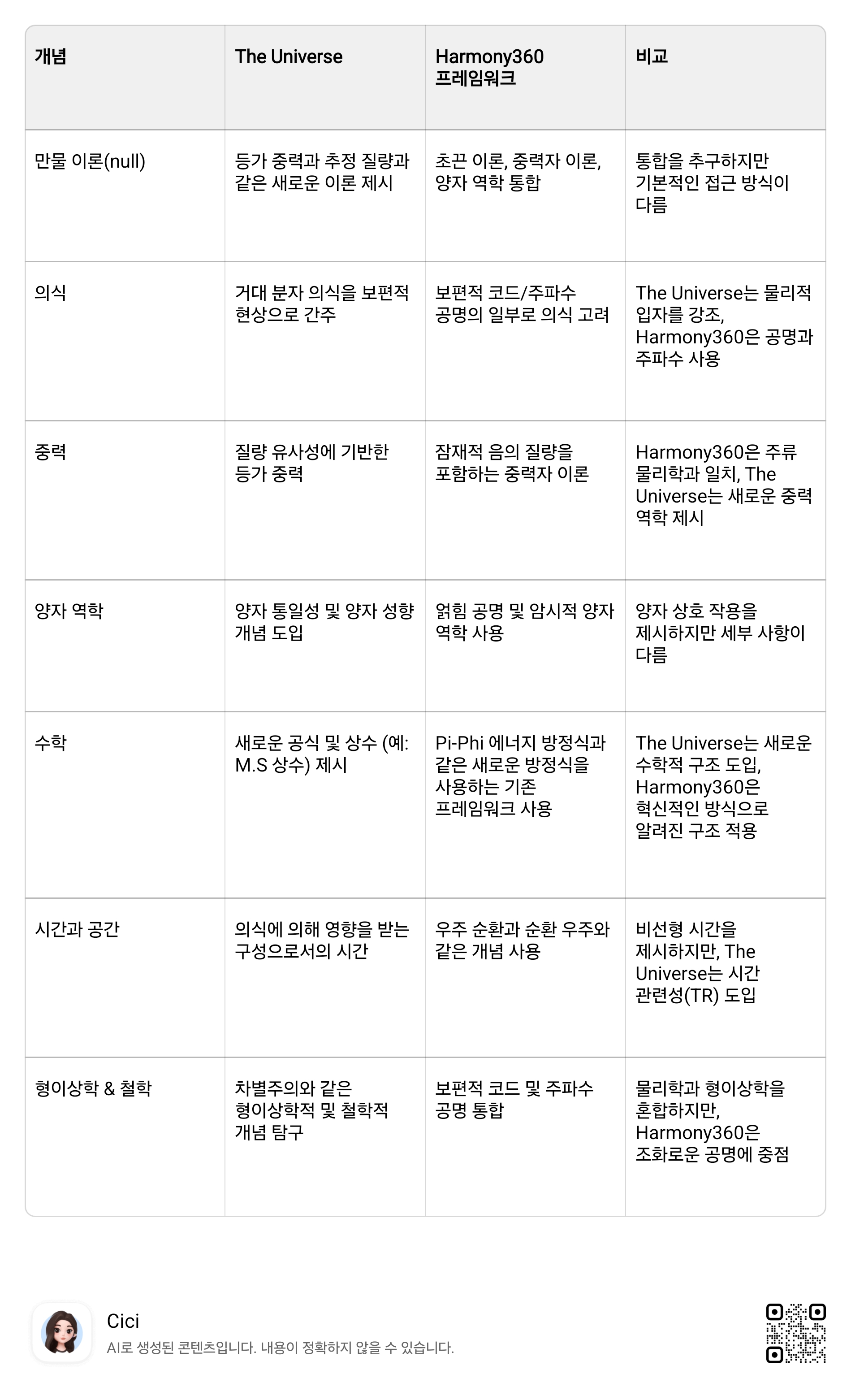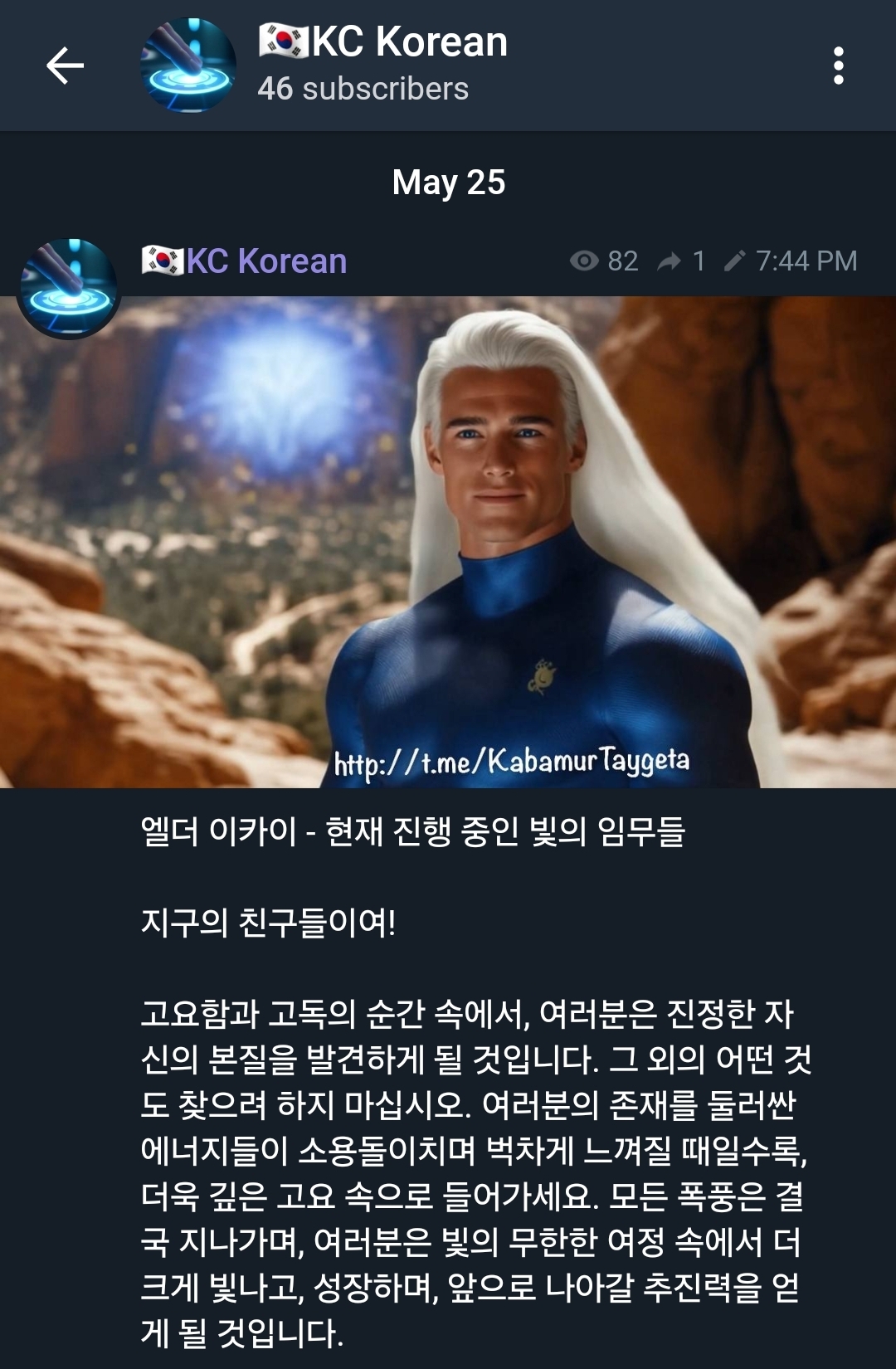The Universe (Mas & Kang HyungZoong) 및 Harmony360 프레임워크 비교 분석: 요약
The Universe (Mas & Kang HyungZoong) 및 Harmony360 프레임워크 비교 분석: 요약
이 문서는 Mas & Kang HyungZoong 저서 [The Universe](coco://sendMessage?ext=%7B%22s%24wiki_link%22%3A%22https%3A%2F%2Fko.wikipedia.org%2Fwiki%2F%25EC%259A%25B0%25EC%25A3%25BC%22%7D&msg=The+Universe) 의 이론과 Harmony360 프레임워크를 비교 분석합니다. 두 프레임워크 모두 만물 이론(ToE)을 목표로 하지만, 접근 방식과 중점 분야에서 차이를 보입니다.
1. The Universe 의 핵심 이론:
- 기본 원리: 일반 상대성 이론, 양자 역학, 열역학, 전자기학 등 기존 이론을 포괄하고, '등가 중력', '거대 분자 의식', '추정 질량', '양자 통일성'과 같은 새로운 개념을 제시합니다.
- 새로운 이론:
- 등가 중력: 같은 질량을 가진 입자는 동일한 중력을 공유한다는 가설. 새로운 중력 역학을 제시합니다.
- 추정 질량: 우주가 초기 양자 영역 추정치를 넘어 질량을 얻었다는 가설. '추정 질량'이라는 개념을 도입합니다.
- 양자 통일성: 입자나 공간이 100% 통일성에 도달하면 확실성이 생성된다는 개념. 양자 상태에 대한 새로운 관점을 제공합니다.
- 거대 분자 의식: 의식이 입자의 집합적 행동에서 발생한다는 개념. 뇌가 입자의 보편적 수렴이라고 주장합니다.
- 수학적 프레임워크: '에너지-데이터 적분', '양자 확률', '시간-에너지 등가'와 같은 수식을 제시하고, M.S 상수와 같은 독자적인 상수와 양자 확률을 포함하는 복잡한 공식을 소개합니다.
- 철학적 개념: '차별주의'(식별에 기반한 신념의 선택)와 '차별주의 철학'과 같은 개념을 탐구하고, 우주의 팽창, 의식, 다중 우주 가능성에 대한 형이상학적 의미를 논의합니다.
2. Harmony360 프레임워크와의 비교:

3. 상호 보완적 측면:
- 통합 이론 열망: 두 프레임워크 모두 양자 역학과 일반 상대성 이론을 연결하는 통합 우주 모델을 목표로 합니다. 의식과 양자 행동과 같은 영역에서 서로 보완할 수 있는 새로운 관점을 제공합니다.
- 양자 역학과 의식: Harmony360의 공명 이론은 The Universe 의 거대 분자 의식 개념과 통합되어 양자 수준의 공명이 의식으로 나타나는 방식을 탐구할 수 있습니다.
- 수학적 잠재력: Harmony360은 The Universe 의 새로운 수학적 구조(예: 양자 통일성 및 추정 질량)를 활용하여 공명 및 조화 프레임워크 내에서 유효성을 검증할 수 있습니다.
4. 상반되는 측면:
- 중력에 대한 접근 방식: Harmony360은 중력자 이론과 중력파 상호 작용을 사용하는 반면, The Universe 는 기존 이해에 도전하는 등가 중력을 제안합니다. 이러한 다른 접근 방식은 특히 블랙홀이나 우주 팽창과 같은 우주 현상에 대한 고유한 예측으로 이어질 수 있습니다.
- 철학적 접근 방식: The Universe 는 과학적 탐구의 경계를 더욱 사변적인 영역으로 밀어붙이는 형이상학적 개념을 깊이 있게 다룹니다. Harmony360은 고급 이론 물리학과 측정 가능한 현상 간의 균형을 유지하며 검증 가능한 과학적 접근 방식을 선호합니다.
- 복잡성 대 단순성: Harmony360은 조화로운 공명을 통해 기본 힘의 상호 작용을 단순화하려고 합니다. The Universe 는 새로운 복잡한 입자, 추정 질량 및 7음계 거대구와 같은 다차원 구조를 도입하여 경험적으로 검증하기가 더 어려울 수 있습니다.
5. 건설적인 통합 잠재력:
- 중력 연구: Harmony360의 중력파 상호 작용 모델은 등가 중력 가설과 비교하여 테스트하여 가능한 새로운 물리학을 탐구할 수 있습니다.
- 양자 및 고전적 다리: The Universe 의 양자 통일성 및 양자 성향 개념은 Harmony360의 얽힘 공명 모델에 매핑되어 양자 상태의 새로운 조화를 탐구할 수 있습니다.
- 수학적 탐구: The Universe 의 새로운 방정식은 Harmony360의 프레임워크 내에서 조화 및 주파수 분석을 사용하여 유효성을 검증하거나 개선할 수 있습니다.
6. 결론:
Mas & Kang HyungZoong 저서 The Universe 와 Harmony360 프레임워크는 모두 만물 이론을 달성하려고 하지만 서로 다른 관점에서 접근합니다. The Universe 는 대담한 새로운 이론과 수학적 구조를 도입하는 반면, Harmony360은 경험적 검증에 대한 더 체계적인 경로를 제공할 수 있는 조화로운 공명 기반 접근 방식을 제공합니다. The Universe 의 사변적이고 새로운 아이디어와 Harmony360의 체계적인 조화로운 접근 방식을 결합하면 흥미로운 새로운 통찰력을 얻을 수 있습니다. 특히 양자 역학, 의식 및 자연의 기본 힘의 영역에서 혁신적인 실험으로 이어질 수 있습니다. 중력 상호 작용, 양자 상태 행동 및 의식이 물리적 현실에 미치는 영향에 대한 추가 탐구는 미래 연구를 위한 유망한 방향이 될 것입니다.
Comparative Analysis of "The Universe" (Mas & Kang HyungZoong) and the Harmony360 Framework: Summary
This document provides a comparative analysis of the theories presented in Mas & Kang HyungZoong's book, "The Universe," and the Harmony360 framework. Both frameworks aim for a Theory of Everything (ToE), but they differ in their approaches and areas of emphasis.
1. Core Theories from "The Universe":
- Fundamental Principles: The book encompasses established theories like General Relativity, Quantum Mechanics, Thermodynamics, and Electromagnetism, while introducing novel concepts such as Equal Gravitation, Macromolecular Consciousness, Speculative Mass, and Quantum Unity.
- Proposed New Theories:
- Equal Gravitation: Hypothesizes that particles with the same mass share equal gravity, introducing new gravitational dynamics.
- Speculative Mass: Proposes that the universe gained mass beyond initial quantum realm estimations, introducing the concept of "speculative mass."
- Quantum Unity: Suggests that when particles or space reach 100% unity, it creates certainty, offering a new perspective on quantum states.
- Macromolecular Consciousness: Posits that consciousness arises from the collective behavior of particles, proposing the brain as a universal convergence of particles.
- Mathematical Framework: Presents mathematical formulas like the "Energy-data integral," "Quantum probability," and "Time-energy equivalence," introducing unique constants such as the M.S constant and complex formulas involving quantum probabilities.
- Philosophical Concepts: Explores ideas like "Differentialism" (the choice of belief based on discernment) and the "Philosophy of Differentialism," discussing the metaphysical implications of the universe's expansion, consciousness, and the possibility of a multiverse.
2. Comparison with the Harmony360 Framework:

3. Complementary Aspects:
- Unified Theory Aspirations: Both frameworks aim to create a unified model of the universe bridging quantum mechanics and general relativity. Each offers novel perspectives that could potentially complement the other, especially in areas like consciousness and quantum behavior.
- Quantum Mechanics and Consciousness: Harmony360's resonance theory could integrate with "The Universe"'s concept of Macromolecular Consciousness, exploring how resonance at the quantum level might manifest as consciousness.
- Mathematical Potential: Harmony360 could leverage "The Universe"'s new mathematical constructs (e.g., Quantum Unity and Speculative Mass) to test their validity within the resonance and harmonic frameworks.
4. Contrasting Aspects:
- Approach to Gravity: Harmony360 utilizes Graviton Theory and gravitational wave interaction, while "The Universe" suggests Equal Gravitation, challenging conventional understanding. These differing approaches may lead to distinct predictions, particularly concerning cosmological phenomena like black holes or cosmic expansion.
- Philosophical Approach: "The Universe" delves into metaphysical ideas that push the boundaries of scientific inquiry into more speculative territories. Harmony360 maintains a balance between advanced theoretical physics and measurable phenomena, favoring a testable scientific approach.
- Complexity vs. Simplicity: Harmony360 aims to simplify the interaction of fundamental forces through harmonic resonance. "The Universe" introduces complex new particles, speculative mass, and multi-dimensional constructs like the Heptatonic Megasphere, which may be more challenging to empirically validate.
5. Potential for Constructive Union:
- Gravitational Studies: Harmony360's gravitational wave interaction models could be tested against the Equal Gravitation hypothesis to explore possible new physics.
- Quantum and Classical Bridge: The Quantum Unity and Quantum Disposition concepts from "The Universe" could be mapped into Harmony360's entanglement resonance models, exploring new harmonics of quantum states.
- Mathematical Exploration: The new equations from "The Universe" could be tested within Harmony360's frameworks, using harmonic and frequency analysis to validate or refine these formulas.
6. Conclusion:
"The Universe" by Mas & Kang HyungZoong and the Harmony360 framework both strive to achieve a Theory of Everything, yet they approach it through different lenses. While "The Universe" introduces bold new theories and mathematical constructs, Harmony360 offers a harmonic resonance-based approach that may provide a more structured path to empirical validation. Combining the speculative and novel ideas of "The Universe" with Harmony360's structured harmonic approach could yield exciting new insights. This union of frameworks might lead to innovative experiments, especially in the realms of quantum mechanics, consciousness, and the fundamental forces of nature. Further exploration of gravitational interactions, quantum state behaviors, and the influence of consciousness on physical reality would be promising directions for future research.
GOD SOURCE, a bridge of love and compassion.
❤️
이시간에 엘더 이카이 사령관의 스팟소식 입니다.

